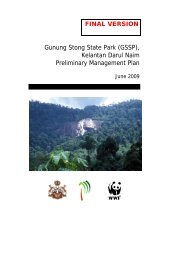WWFM_Hill Stations Study Vol2_2001.pdf - Sdn Bhd - WWF Malaysia
WWFM_Hill Stations Study Vol2_2001.pdf - Sdn Bhd - WWF Malaysia
WWFM_Hill Stations Study Vol2_2001.pdf - Sdn Bhd - WWF Malaysia
Create successful ePaper yourself
Turn your PDF publications into a flip-book with our unique Google optimized e-Paper software.
<strong>Study</strong> on the Development of <strong>Hill</strong> <strong>Stations</strong><br />
Final Report II<br />
EXECUTIVE SUMMARY<br />
Strengths<br />
80. The main strength of this hill station is its cool climate which is a significant<br />
attraction for residents of nearby Taiping and the state capital of Ipoh, as<br />
well as other domestic visitors and a small number of foreign visitors.<br />
81. Bukit Larut serves as a nature retreat to the residents of settlements such as<br />
Taiping and Ipoh and it also embodies historic, architectural and aesthetic<br />
values. The hill station is also serene and scenic and abounds with groves<br />
of evergreens and colourful flora and fauna.<br />
82. Bukit Larut possesses one of the richest flora for any hill stations within the<br />
country with a significant proportion of it consisting of rare and endemic<br />
species. Bukit Larut contains 20% of the total number of Peninsular<br />
<strong>Malaysia</strong>’s fern species and 17% of <strong>Malaysia</strong>n montane orchids.<br />
Weaknesses<br />
83. The absence of a statutory land use plan for the Bukit Larut may attract<br />
incompatible development proposals that may be detrimental to the hill<br />
station and the surrounding heritage sites, particularly the lake gardens. The<br />
lack of development controls and guidelines may threaten the natural beauty<br />
of the resort through incompatible development proposals.<br />
84. At present the major weakness is that this hill resort is not widely promoted<br />
and is relatively unknown especially in foreign markets. It has not been<br />
widely promoted even within <strong>Malaysia</strong>.<br />
85. The tourism infrastructure is poor. The bungalows are in need of upgrading<br />
with e.g. better interior decoration, more self-catering facilities and improved<br />
heating. Accessibility needs to be improved and there is a clear need for<br />
better interpretative and informative signage as well as possible safety<br />
problems that could arise from the unstable nature of the slopes.<br />
86. There is limited recent information on biodiversity on Bukit Larut. Although<br />
information on the biodiversity of Bukit Larut is available, most of this are<br />
derived from old literature and do not reflect the comprehensive range of<br />
biodiversity found here.<br />
87. The existing Educational Forest located at the foothill of Bukit Larut and is<br />
run by the District Forestry Office, although is a good initiative, lacks<br />
publicity, and hence unknown to many visitors.<br />
88. The only known forest trail in Bukit Larut, which leads to the peak of Gunung<br />
Hijau has been closed to public. The trail is unmarked and overgrown.<br />
These coupled with the fact that the trail is narrow and dangerous in places,<br />
pose a safety hazard to users.<br />
<strong>WWF</strong> <strong>Malaysia</strong> E- 11<br />
December 2001
















